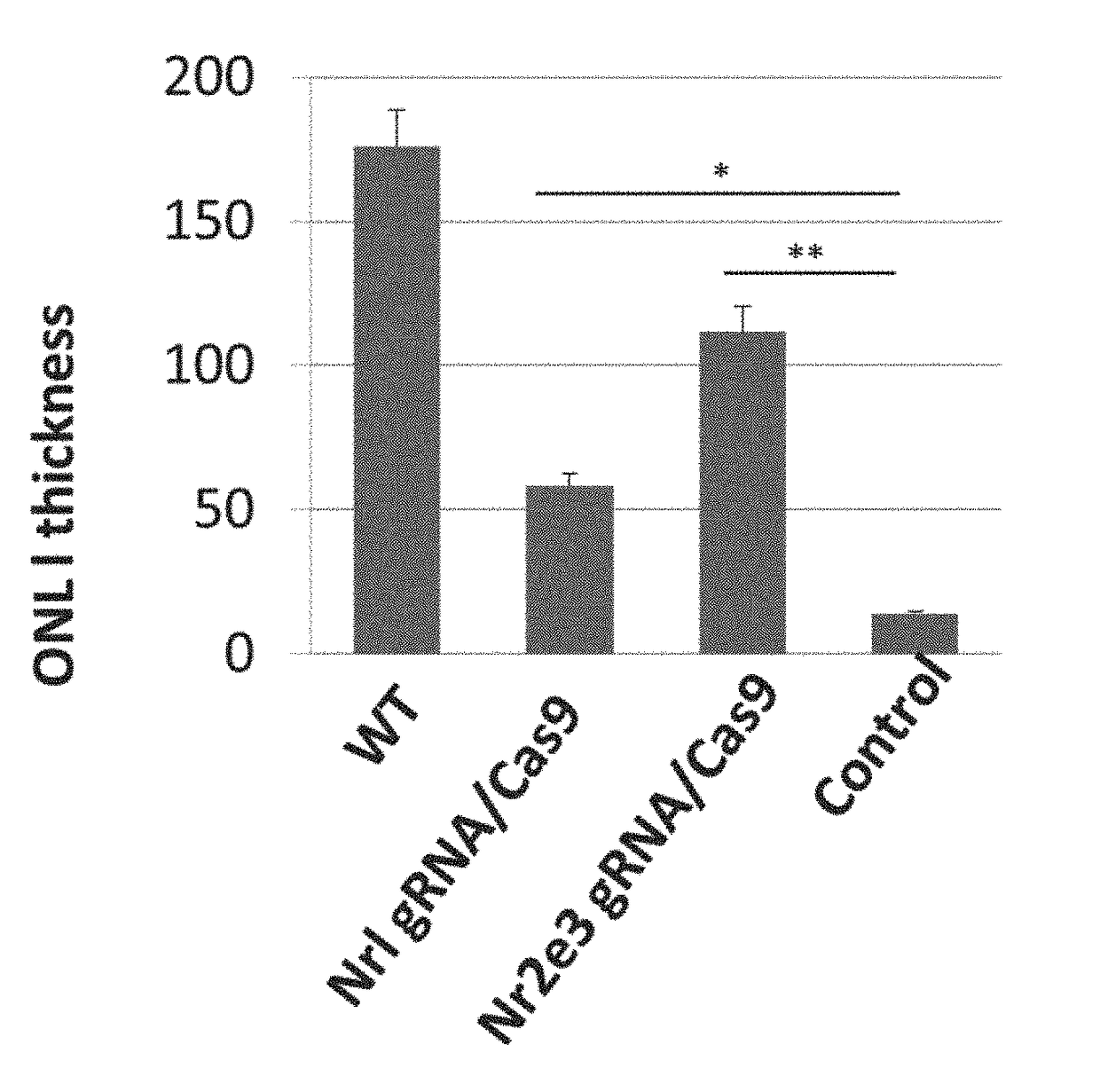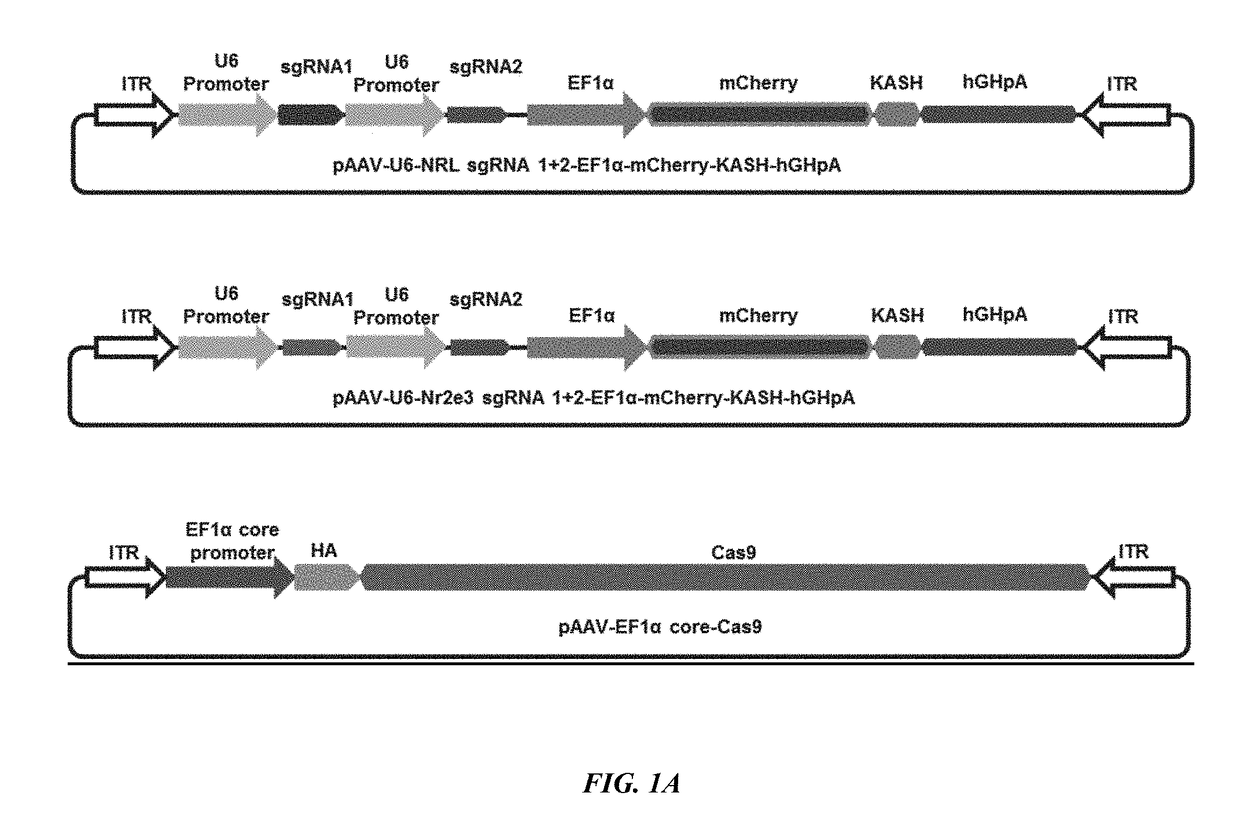Methods and compositions for cellular reprogramming
a cellular reprogramming and composition technology, applied in drug compositions, viruses/bacteriophages, extracellular fluid disorders, etc., can solve the problems of detriment and detrimental effects, and achieve the effect of less protein
- Summary
- Abstract
- Description
- Claims
- Application Information
AI Technical Summary
Benefits of technology
Problems solved by technology
Method used
Image
Examples
example 1
s9 Targeting with Two Guide RNAs In Vitro
[0265]To test a CRISPR-CAS9 based cellular reprogramming strategy to treat RP and preserve visual function, two AAV vectors were employed, one expressing Cas9, and another carrying gRNAs targeting NRL or NR2E3 gene (see FIG. 1A). To construct double gRNA expression vectors, pAAV-U6 gRNA-EF1a mCherry was used. Both 20 bp gRNA sequences were sub-cloned into the vector separately. The CRISPR / Cas9 target sequences (20 bp target and 3 bp PAM sequence showed with underline) used in this study are shown as following: GAGCCTTCTGAGGGCCGATC TGG (SEQ ID NO. 1), and GTATGGTGTGGAGCCCAACG AGG (SEQ ID NO. 2) for NRL knockdown, GGCCTGGCACTGATTGCGAT GGG (SEQ ID NO. 3), and AGGCCTGGCACTGATTGCGA TGG (SEQ ID NO. 4) for NR2E3 knockdown. Targeting and inactivation efficiency by simultaneously targeting two sites by two gRNAs in the same gene was assessed against targeting and inactivation efficiency of a single gRNA. Gene knockdown efficiency in mouse fibroblasts ...
example 2
s9 Targeting with Two Guide RNAs In Vivo
[0266]AAVs encoding Cas 9 and two guide RNAs targeting the NRL gene were delivered to WT mice via subretinal injections at P0 (postnatal day 7). Briefly, eyes of anesthetized mice were dilated and, under direct visualization with a dissecting microscope, 1 μl AAV mixture was injected into the subretinal space through a small incision using a glass micropipette (internal diameter 50˜75 μm) and a pump microinjection apparatus (Picospritzer III; Parker Hannifin Corporation). Successful injections were noted by creation of a small subretinal fluid bleb. Any mice showing retinal damage, such as bleeding, were not included in the study. P30 mice were sacrificed for histology. Retinas were frozen sectioned and stained for cone markers, including anti-mouse cone arrestin (mCAR) antibody and anti-medium wavelength opsin (M-opsin) antibody. mCherry was also imaged as a marker to label transduced areas and cells by AAV vectors. Results showed that AAV8-C...
example 3
l Injections of Retinal Pigmentosa (RP) Model Mouse with AAV Encoding Cas9 / CRISPR System Targeting NRL or NR2E3
[0267]To test the hypothesis that partial conversion of degenerating rods into cones is sufficient to rescue retinal degeneration and restore retinal function, AAV-gRNA / Cas9 was injected into the subretinal space in RD10 mice at P0. RD10 mice are a model of autosomal recessive RP in humans with rapid rod photoreceptor degeneration. RD10 mice carry a spontaneous mutation of the rod-phosphodiesterase (PDE) gene, leading to rapid rod degeneration that starts around P18. Rod degeneration completes in postnatal 60 days with concurrent cone degeneration. Because photoreceptor degeneration does not overlap with retinal development, and light responses can be recorded for about a month after birth, RD10 mice mimic typical human RP more closely than other RD models such as rd1 mutants.
[0268]Analyses were performed between postnatal 7-8 weeks. To determine the effect of this AAV-gRNA...
PUM
| Property | Measurement | Unit |
|---|---|---|
| Fraction | aaaaa | aaaaa |
| Composition | aaaaa | aaaaa |
Abstract
Description
Claims
Application Information
 Login to View More
Login to View More - R&D
- Intellectual Property
- Life Sciences
- Materials
- Tech Scout
- Unparalleled Data Quality
- Higher Quality Content
- 60% Fewer Hallucinations
Browse by: Latest US Patents, China's latest patents, Technical Efficacy Thesaurus, Application Domain, Technology Topic, Popular Technical Reports.
© 2025 PatSnap. All rights reserved.Legal|Privacy policy|Modern Slavery Act Transparency Statement|Sitemap|About US| Contact US: help@patsnap.com



